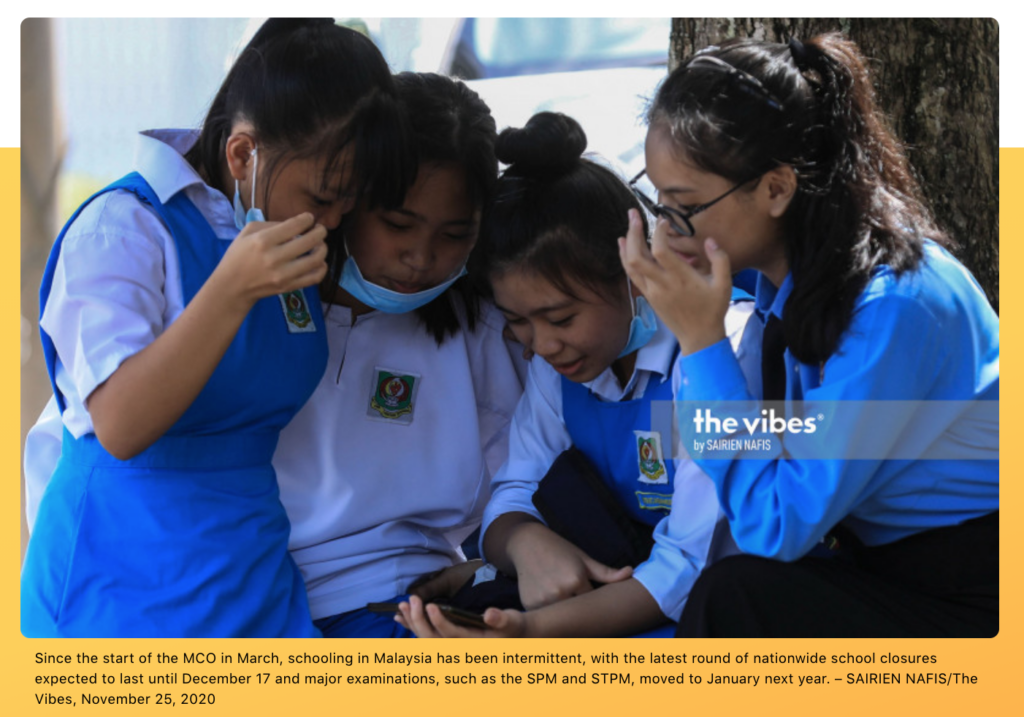Youth perspective on Budget 2021 – Nadia Malyanah and Tharma Pillai

Original article was published on 25th November 2020 on The Vibes.
TOMORROW, our parliamentarians will be voting on Budget 2021, which will make or break Tan Sri Muhyiddin Yassin’s government. While the political battle to become or remain government is ongoing, we cannot forget that this is the most important Budget in the past decade.
As Covid-19 keeps upending the world as we know it and has continued to impact millions of lives, there was much anticipation among Malaysian youth to see what the government has budgeted to help those who have been severely impacted by the pandemic.
The youth make up more than half of Malaysia’s total population of 32.7 million. We are the students, the young professionals, the pasar malam sellers, the parents with young children, the homeowners and many more.
So did Budget 2021 live up to expectations of the youth? Let’s take a look.
Education, and ‘a lost generation’
A rather impressive RM50.4 billion has been allocated to the Education Ministry for Budget 2021, which makes up 15.6% of the total budget. Among specific measures that were announced were RM420 million for daily milk supplement scheme under the Rancangan Makanan Tambahan (RMT) programme, RM800 million for the upgrade and maintenance of government schools and government-assisted schools and RM50 million for stable internet connection in universities through MYREN (Malaysian Research & Education Network) broadband access upgrade from 500bps to 10Gbps.
Since the initial movement control order (MCO) in March, schooling in Malaysia has been intermittent: the latest round of nationwide school closures are expected to last until December 17, with major examinations such as the SPM and STPM moved to January next year.
These closures involve approximately five million students and 500,000 teachers who are now expected to rely heavily on home-based teaching and learning. But Malaysia’s insufficient digital infrastructure and limited to zero access to digital devices are significantly hampering students from urban and rural poor backgrounds.
Stories of teachers going the extra mile to send and fetch their students printed materials, while commendable, have laid bare the gaps in the inability of our education system to fully adapt and cope to the new norms.
In her Budget 2021 speech, Kulai MP and former deputy education minister Teo Nie Ching noted that at least 37% or 1.7 million students under the Education Ministry did not have the devices to enable them to participate in online teaching and learning sessions.
These students do not own a laptop, tablet or desktop computer and are, therefore, categorised as “digitally poor”. Additionally, poor internet access and connectivity in rural and interior areas of Malaysia remain a persistent problem.
The RM150 million Cerdik Fund is an effort to tackle the digital poverty problem: it will be used to provide laptops to 150,000 pupils at 500 schools as a pioneer project under the supervision of the Hasanah Foundation.
But the very task of closing the digital divide itself largely falls upon the Communications and Multimedia Ministry, which oversees a portion of the funds allocated for this purpose. At least RM500 million is allocated for the National Digital Network (Jendela) initiative, which aims to enhance internet connectivity at 430 schools nationwide, with RM7.4 billion allocated for the purpose of widening broadband services in 2021 and 2022.
The allocation of RM100 million in loans for higher education students with PTPTN loans for the purpose of purchasing laptops through Skim BSN MyRinggit-i COMSIS is commendable. But structuring it as a loan rather than a rebate risks saddling these students with more debt, as it seems that eligibility for this scheme is tied to their PTPTN loan.
The RM75 million allocation for eBelia, which credits a one-off amount of RM50 into the e-wallets of youth aged 18 to 20 is also seen as a short-sighted and populist measure. Other than that, little seems to be available to varsity students in terms of actual monetary aid.
Employment and social protection nets
Generating and retaining jobs is also a rather significant strategy outlined within Budget 2021, with RM3.7 billion allocated for the JanaKerja Scheme to provide 500,000 new job opportunities, including skills upgrading and retraining. Additionally, the recruitment of more workers is also encouraged via Socso’s six-month incentives. A total of RM1 billion has been allocated for the purpose of reskilling & upskilling workers, along with RM700 million to enable the public sector and GLCs to offer 50,000 temporary job opportunities.
The targeted wage subsidy extension itself has also been given an allocation of RM1.5 billion. The focus of the Budget 2021 iteration, however, is on tourism and retail sectors, with RM600 per employee with a salary of RM4,000 and below for up to 500 employees. But there is little long-term relief from this Budget. The possible extension of the conditional movement control order (CMCO) currently imposed in a number of Malaysian states until next January may still end up destroying these heavily impacted industries altogether, and further put livelihoods at stake. For instance, lesser-known economic industries such as grassroots sports need survival funds and gradual ease of restrictions for these industries to begin operating, or at least restructure their operations for the long term.
The move to allow a withdrawal of maximum RM6,000 over the span of 12 months from Account 1 of the Employees Provident Fund (EPF) will greatly benefit those who need it. But what of those with insufficient EPF savings – at least 5.38 million (43%) active EPF members have less than RM10,000 in Account 1 – or those who require a higher withdrawal amount?
While the enhanced targeted loan repayment assistance (TLRA) measures for B40 and M40 borrowers are encouraging, a blanket moratorium until the end of 2020 is perhaps an easier way of alleviating the rakyat’s financial fears. The third wave of Covid-19 cases, and the perpetual extension of the CMCO has caused many to lose a significant portion of their income, or their jobs entirely.
Keeping SMEs afloat
Malaysia’s small and medium enterprises (SMEs) account for two-thirds of the country’s workforce and nearly 40% of the economy. The news that at least 32,469 SMEs have been forced to cease operations between March and September this year have been a worrying one for many, as Covid-19 has essentially forced most SMEs to go into survival and transformation mode. There were long wish lists from SMEs, but did the government manage to meet them halfway?
The structuring of entrepreneurial aid according to communities in Budget 2021 itself is a particularly odd choice, when it touts itself as “promoting the inclusivity agenda”. A total of RM4.6 billion has been set aside to assist Bumiputera entrepreneurs by providing several financing options. These include funnelling RM510 million for Bumiputera SMEs and micro SMEs via Tekun and PUNB, RM800 million for development of Bank Pembangunan Malaysia and SME Bank as well as RM2 billion for Bumiputera SMEs through Syarikat Jaminan Pembiayaan Perniagaan (SJPP).
On the other hand, RM20 million is provided specifically for Skim Pembangunan Usahawan Masyarakat India (SPUMI), with another RM5 million for entrepreneurship development for other minority communities. Nevertheless, financially affected SMEs will now have the option of looking into the RM2 billion Targeted Assistance and Rehabilitation Facility. These funds will be parked under Bank Negara’s jurisdiction and introduced via bank loans.
Nevertheless, the focus on long-term productivity by accelerating the digitalisation of these SMEs operations and trade channels is rather encouraging. The RM1 billion Industrial Digitalisation Transformation Scheme, which aims to boost digitalisation activities, will be provided via Bank Pembangunan Malaysia Bhd (BPMB). An additional RM150 million will also be injected into the existing SME Digitalisation Grant Scheme and Smart Automation Grants.
Families and the burden of childcare
Budget 2021 leaves much to be desired in terms of gender responsiveness, as it insufficiently accounts for the disproportionate care burden faced by women during the pandemic. For instance, the recent spike of Covid-19 has also led to the closure of childcare centres and kindergartens in Malaysia, particularly in red-zone areas due to the high number of active cases. The impact of this on Malaysian women has been two-fold, as this affects those working in these sectors and those who are unable to work from home (especially front-line workers) and require childcare. The allocation of RM30 million to establish childcare centres in government buildings, and a matching grant valued at RM20 million to encourage private sector employees to provide childcare in Budget 2021, feels like a well-meaning but slow response to these problems. So far, it is difficult to tell whether operating restrictions will be lifted, with better coordination between government agencies involved as well as proper operating SOPs in place will materialise.
Time and opportunity costs as well as the physical demands of unpaid care work does have a severe and negative impact on women’s well-being and economic independence. Unpaid care work does limit women’s access to paid employment, as it restricts the types of jobs to which women have access to. Additionally, women who opt for irregular, or self-employment have been extremely vulnerable to disruptions caused by Covid-19. So the government’s move to encourage more women entrepreneurs by funnelling RM95 million into micro credit schemes through Tekun, Mara and AgroBank, as well as RM50 million for Islamic financing through Ar-Rahnu BizNita is rather timely, in this sense. However, there is still room for improvement: there are no specific schemes to encourage women to retrain, or re-enter the workforce after long career breaks.
Other notable Budget 2021 allocations targeted for women include RM10 million for cervical cancer screening and subsidy incentives for mammograms to women who face high risk of breast cancer, as well as a RM21 million allocation to set up local social support centres for domestic violence victims. The latter is seen as a good start, even if the amount is somewhat underwhelming in comparison with recommendations mooted by the Women’s Aid Organisation (WAO). WAO’s recent report on Budget 2021 had recommended RM50 million to improve existing shelters and build new ones for gender-based violence survivors, with an additional RM5 million to operate and improve 24-7 telephone crisis service in Malaysia, including both public and NGO-operated emergency hotlines.
How are we paying for all this?
Budget 2021 seems to be making rather grand promises on paper – it’s been repeatedly touted as the largest budget in Malaysian history – when there has been no increase to current government income, or addition of taxes. The revenue projected by the Malaysian government was based on 2019 figures, which is misplaced optimism, as we arrived at these numbers prior to a worldwide pandemic and seemingly without accounting for decreasing oil prices.
There is a very pressing need for the Malaysian government to explore more alternative ways of raising revenue, be it via borrowing, or the introduction of new taxes such as the “windfall” tax that have been suggested by some parliamentarians. Without measures to increase revenue, many of the more important and expensive parts of Budget 2021 will never be implemented.
But does the “largest ever budget” moniker even benefit young Malaysians?
Whether the current government is truly open to making changes and concessions to ensure the 2021 Budget gets safely passed in Parliament tomorrow remains to be seen, but an extraordinary year requires an extraordinary budget. With low interest rates globally, the government needs to borrow and spend to ensure that jobs are saved, businesses can recover and we can avoid a prolonged recession. While there are many good things, this budget clearly doesn’t go far enough. This government can and must do better for the rakyat. – The Vibes, November 25, 2020
Nadia Malyanah and Tharma Pillai are from youth organisation UNDI18

